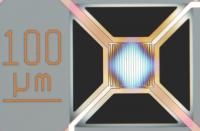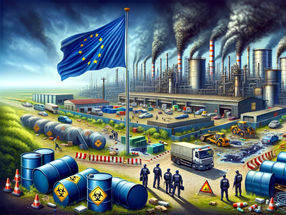From Dichromium tris(chromate) to Lead dipicrate: Public Consultation on 20 potential Substances of Very High Concern
Advertisement
The European chemicals Agency (ECHA) has published proposals to identify 20 chemicals as Substances of Very High Concern (SVHCs) and thus as possible candidates for authorisation. From the last publication six months ago, the number of dossiers has more than doubled. The detailed proposals are available on the ECHA website. Interested parties are invited to comment on the proposals by 13 October 2011.
Several Member States and ECHA (at the request of the European Commission) have put forward proposals to identify 20 chemical substances as Substances of Very High Concern (SVHCs). Anyone can comment on these proposals within the next 45 days. The names of the substances, the reasons for their proposal as SVHC and their uses are provided in the attached table.
Comments should focus primarily on the hazardous properties that qualify the chemicals as SVHCs and on the substance identity. In addition, interested parties can provide comments and further information on the uses, exposures and availability of safer alternative substances or techniques. They should be aware that these aspects will mainly be considered at the next stage of the process (i.e. selection of substances for authorisation), which includes a new round of public consultation.
The Member State Committee will review these comments when seeking an agreement on the identification of the proposed substances as SVHCs, and before ECHA includes the agreed substances on the Candidate List. Substances on the Candidate List may be selected for authorisation.
Nineteen substances are proposed because of their potentially serious effects on human health. They are classified as carcinogenic and/or toxic for reproduction. In addition, one substance is proposed to be identified as a substance of equivalent concern in accordance with Article 57(f) of the REACH Regulation because of its endocrine disrupting properties and potential for serious effects to the environment.
For two of the substances, Aluminosilicate refractory ceramic fibres and Zirconia aluminosilicate refractory ceramic fibres, proposals to identify them as SVHC were submitted previously and they have been included in the Candidate List in January 2010. However, it turned out that the substance definitions in the Annex XV dossiers supporting the identification of these fibres as SVHC were too narrow to cover the composition of all types of refractory ceramic fibres on the European market. The new SVHC proposals for these fibres therefore provide a wider substance definition intended to cover all types of refractory ceramic fibres used in the EU.
There are already 53 substances on the Candidate List. Inclusion on the list imposes new information requirements on suppliers of preparations and articles containing the substances.
Substances proposed for identification as SVHC, reasons for their proposal, and their potential uses according to information provided in the Annex XV dossiers submitted for the substances.
|
Substance name |
EC number |
CAS number |
Proposed SVHC property |
Potential uses |
|
Dichromium tris(chromate) |
246-356-2 |
24613-89-6 |
Art. 57 (a), carcinogenic |
Mainly used in mixtures for metal surface treatment in the aeronautic/aerospace, steel and aluminium coating sectors. |
|
Potassium hydroxyoctaoxodizincatedi-chromate |
234-329-8 |
11103-86-9 |
Art. 57 (a), carcinogenic |
Mainly used in coatings in the aeronautic/ aerospace, steel and aluminium coil coating and vehicle coating sectors. |
|
Pentazinc chromate octahydroxide |
256-418-0 |
49663-84-5 |
Art. 57 (a), carcinogenic |
Mainly used in coatings in the vehicle coating and aeronautic / aerospace sectors. |
|
Aluminosilicate Refractory Ceramic Fibres (RCF) |
- |
- |
Art. 57 (a), carcinogenic |
Refractory ceramic fibres are used for high-temperature insulation, almost exclusively in industrial applications (insulation of industrial furnaces and equipment, equipment for the automotive and aircraft/aerospace industry) and in fire protection (buildings and industrial process equipment). |
|
Zirconia Aluminosilicate Refractory Ceramic Fibres (Zr-RCF) |
- |
- |
Art. 57 (a), carcinogenic |
Refractory ceramic fibres are used for high-temperature insulation, almost exclusively in industrial applications (insulation of industrial furnaces and equipment, equipment for the automotive and aircraft/aerospace industry) and in fire protection (buildings and industrial process equipment). |
|
Formaldehyde, oligomeric reaction products with aniline (technical MDA) |
500-036-1 |
25214-70-4 |
Art. 57 (a), carcinogenic |
Mainly used for manufacture of other substances. Minor uses are as hardener for epoxy resins, e.g. for the production of rolls, pipes and moulds, and as well for adhesives. |
|
Bis(2-methoxyethyl) phthalate |
204-212-6 |
117-82-8 |
Art. 57 (c), toxic for reproduction |
No registration for this phthalate compound has been submitted to ECHA. Hence, the substance seems not to be manufactured in or imported to the EU in quantities above 1 t/y. Main uses in the past were as plasticiser in polymeric materials and paints, lacquers and varnishes, including printing inks. |
|
2-Methoxyaniline; o-Anisidine |
201-963-1 |
90-04-0 |
Art. 57 (a), carcinogenic |
Mainly used in the manufacture of dyes for tattooing and coloration of paper, polymers and aluminium foil. |
|
4-(1,1,3,3-tetramethylbutyl)phenol, (4-tert-Octylphenol) |
205-426-2 |
140-66-9 |
Art. 57 (f), equivalent level of concern |
Mainly used in the manufacture of polymer preparations and of ethoxylates. Further used as a component in adhesives, coatings, inks and rubber articles. |
|
1,2-Dichloroethane |
203-458-1 |
107-06-2 |
Art. 57 (a), carcinogenic |
Mainly used for manufacture of other substances. Minor uses as solvent in the chemical and pharmaceutical industry. |
|
Bis(2-methoxyethyl) ether |
203-924-4 |
111-96-6 |
Art. 57 (c), toxic for reproduction |
Used primarily as a reaction solvent or process chemical in a wide variety of applications. Used also as solvent for battery electrolytes, and possibly in other products such as sealants, adhesives, fuels and automotive care products. |
|
Arsenic acid |
231-901-9 |
7778-39-4 |
Art. 57 (a), carcinogenic |
Mainly used to remove gas bubbles from ceramic glass melt and for improving adhesion between copper foil and resin in the production of laminated printed circuit boards |
|
Calcium arsenate |
231-904-5 |
7778-44-1 |
Art. 57 (a), carcinogenic |
Calcium arsenate is present in complex raw materials imported for manufacture of copper, lead and a range of precious metals. It appears mainly to be used in metallurgical refinement processes to precipitate nickel from molten copper and to manufacture diarsenic trioxide. However, most of the substance seems to be disposed of as waste. |
|
Trilead diarsenate |
222-979-5 |
3687-31-8 |
Art. 57 (a) & (c), carcinogenic & toxic for reproduction |
Trilead diarsenate is present in complex raw materials imported for manufacture of copper, lead and a range of precious metals. The trilead diarsenate contained in the raw materials is in the metallurgical refinement process transformed to calcium arsenate and diarsenic trioxide. Whereas most of the calcium arsenate appears to be disposed of as waste the diarsenic trioxide is used further. |
|
N,N-dimethylacetamide (DMAC) |
204-826-4 |
127-19-5 |
Art. 57 (c), toxic for reproduction |
Used as solvent, mainly in the manufacture of various substances and in the production of fibres for clothing and other applications. Also used as reagent, and in products such as industrial coatings, polyimide films, paint strippers and ink removers. |
|
2,2'-dichloro-4,4'-methylenedianiline (MOCA) |
202-918-9 |
101-14-4 |
Art. 57 (a), carcinogenic |
Mainly used as curing agent in resins and in the production of polymer articles and also for manufacture of other substances. The substance may further be used in construction and arts. |
|
Phenolphthalein |
201-004-7 |
77-09-8 |
Art. 57 (a), carcinogenic |
Mainly used as laboratory agent (in pH indicator solutions), for the production of pH-indicator paper and in medicinal products. |
|
Lead azide Lead diazide |
236-542-1 |
13424-46-9 |
Art. 57 (c), toxic for reproduction |
Mainly used as initiator or booster in detonators for both civilian and military uses and as initiator in pyrotechnic devices. |
|
Lead styphnate |
239-290-0 |
15245-44-0 |
Art. 57 (c), toxic for reproduction |
Mainly used as a primer for small calibre and rifle ammunition. Other common uses are in munition pyrotechnics, powder actuated devices and detonators for civilian use. |
|
Lead dipicrate |
229-335-2 |
6477-64-1 |
Art. 57 (c), toxic for reproduction |
No registration for this substance has been submitted to ECHA. Lead dipicrate is an explosive like lead diazide and lead styphnate. It may be used in low amounts in detonator mixtures together with the two other mentioned lead compounds. |






























































